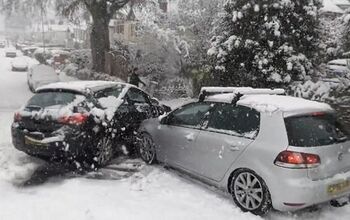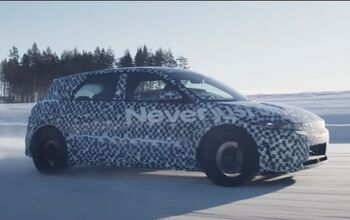Winter Driving Manifesto
Ah, the first snow of the year. The frozen blanket transforms even the ugliest landscapes into crystalline sanctuaries. Crisp air fills the lungs and the inevitable homey smell of a wood fire tells of a distant warming hearth. Earth’s annual metamorphosis triggers a few moments when we get to live a dream stolen from the cover of an old December issue Saturday Evening Post. But for too many, this winter wonderland fantasy is abruptly cut short by the sickening sound of exploding metal, glass and plastic, because the first snow of winter also invites a rash of traffic accidents.
I spent ten winters in northern Utah. Every year, highways ground to a halt from hundreds of traffic accidents on the first day that snow accumulated on road surfaces. I thought, these are Utahans, they should know how to drive on snow. What’s the deal?
Driving on snow and ice requires a recalibration of our timing. By the end of the summer, we don’t think about how long it’s going to take us to brake for an upcoming stop sign on naked pavement; we feel it. Our ingrained habits betray us when water, snow and ice rudely come between us and the road surface. We need practice.
Coming from Texas, I feel disadvantaged driving through white-capped Wasatch Mountains. As George Strait crooned, there’s no Snow in San Antonio. So at the first accumulation of snow, I hop into my old Camry and head for empty parking lots and sparsely traveled back roads for a little automotive me-time.
With no other cars around, I experiment to find out how fast I can corner and stop. I also test to see how steep a road I can safely climb or descend. I re-learn how to finesse both brake and throttle. Back in traffic I’m rightly adjusted to slow-up and allow for proper intervals.
Each year, I repeat this practice ritual at first snow fall. it’s kept me accident-free through rough Rocky Mountain winters.
But despite the drill, getting caught in a blizzard in my trusty old front-wheel drive Toyota still took its toll. I vividly remember white knuckling my way through several snow storms on the road home from grandmother’s house (literally) with my wife and small kids, as I struggled to keep the car on the road and avoid hitting or being hit by other drivers. While the greatest winter driving safety device is the lump of fat and knot of neurons floating between a driver’s ears, equipment also plays a role.
First and foremost are the right tires. On snow and ice, a good pair of snow tires can make even the worst rear wheel-drive (RWD) car a significantly more competent machine. Conversely, the most advanced all wheel-drive systems are rendered impotent with summer meats or worn treads.
Traction control (TC) has emerged as a great equalizer for RWD cars. TC uses either the Anti-lock Brake System or electronically controlled clutches to transfer engine torque to the wheel with the best traction. Last winter I drove a convertible Mustang (top up) through a Chicago snow storm. Despite the superabundance of torque, the pony car’s rear-end stayed safely behind me at all times, without so much as a slip or stall. With the TC off, I turned enough doughnuts to feed the entire Chicago PD.
It would seem that AWD or four-wheel drive cars and trucks are less safe than FWD. Very often we see that the first drivers to slide off the road when the weather turns bad are at the wheel of these “super capable” cars and trucks. But overconfidence is a form of driver error, not equipment failure.
This is an important distinction. When Jack Frost catches a cold, technically the best-equipped cars and truck for safely driving are AWD and 4WDs with appropriate tires.
In low-friction environments, being able to put power to all four wheels can provide up to four times greater traction while acceleration or pulling through a corner over a RWD or FWD car without traction control. To an extent, 4WDs also help in braking due to increased power train drag that allows drivers to moderate their speed without hitting the brakes.
On the down side, these systems add weight and neither improves braking or cornering (except while accelerating). And that’s where lame brain drivers get in trouble. The ability to accelerate on the slippery stuff seems to drain IQ points from drivers.
And so we come full circle. While equipment can help aid drivers, the greatest factor is the man or woman gripping the steering wheel. I love the change in seasons and look forward to winter sports, or just messing around in the snow. But when it gets icy and dicey, nothing beats proper snow tires steered by a calm, practiced, alert and sensible driver.
More by William C Montgomery
Latest Car Reviews
Read moreLatest Product Reviews
Read moreRecent Comments
- TheEndlessEnigma These cars were bought and hooned. This is a bomb waiting to go off in an owner's driveway.
- Kwik_Shift_Pro4X Thankfully I don't have to deal with GDI issues in my Frontier. These cleaners should do well for me if I win.
- Theflyersfan Serious answer time...Honda used to stand for excellence in auto engineering. Their first main claim to fame was the CVCC (we don't need a catalytic converter!) engine and it sent from there. Their suspensions, their VTEC engines, slick manual transmissions, even a stowing minivan seat, all theirs. But I think they've been coasting a bit lately. Yes, the Civic Type-R has a powerful small engine, but the Honda of old would have found a way to get more revs out of it and make it feel like an i-VTEC engine of old instead of any old turbo engine that can be found in a multitude of performance small cars. Their 1.5L turbo-4...well...have they ever figured out the oil dilution problems? Very un-Honda-like. Paint issues that still linger. Cheaper feeling interior trim. All things that fly in the face of what Honda once was. The only thing that they seem to have kept have been the sales staff that treat you with utter contempt for daring to walk into their inner sanctum and wanting a deal on something that isn't a bare-bones CR-V. So Honda, beat the rest of your Japanese and Korean rivals, and plug-in hybridize everything. If you want a relatively (in an engineering way) easy way to get ahead of the curve, raise the CAFE score, and have a major point to advertise, and be able to sell to those who can't plug in easily, sell them on something that will get, for example, 35% better mileage, plug in when you get a chance, and drives like a Honda. Bring back some of the engineering skills that Honda once stood for. And then start introducing a portfolio of EVs once people are more comfortable with the idea of plugging in. People seeing that they can easily use an EV for their daily errands with the gas engine never starting will eventually sell them on a future EV because that range anxiety will be lessened. The all EV leap is still a bridge too far, especially as recent sales numbers have shown. Baby steps. That's how you win people over.
- Theflyersfan If this saves (or delays) an expensive carbon brushing off of the valves down the road, I'll take a case. I understand that can be a very expensive bit of scheduled maintenance.
- Zipper69 A Mini should have 2 doors and 4 cylinders and tires the size of dinner plates.All else is puffery.


































Comments
Join the conversation
My 2008 Wrangler with brand-spanking new Bridgestone snow-tires and 4WD-Low will STILL spin out of control on icy patches in Montreal. It's a fine line between getting to work and landing in a ditch, or worse. How the millions of FWD Echos and Cobalts do it everyday with worn-out snow tires is a mystery.
Um...you'll want to stay out of 4WD-Low. The idea of driving well on low-friction surfaces is to keep the torque way down. The "Lo" increases the torque at a given speed. For example, in "Hi" you may be running 1,000 revs at 5 mph in first gear (below the peak torque of the typical, long-stroke, OHV domestic engine). In "Lo" however, you may be running 2,500 rpm at 5mph and have a lot more torque, ergo, propensity to spin. Leave "Lo" for low-speed, high-torque applications...like stump pulling. Little FWD cars have it easy. Their engines don't make a whole lot of torque, nor do they have transfer cases to increase torque at low operating speeds. Additionally their weight is generally concentrated over their driven wheels and their center of gravity is lower. That - and putting it "Lo" is why you see Jeeps, Blazers, Durangos...in the ditch as you motor by in your fwd econobox. Me, I'll take my Subaru with Pirelli Sotto Zero ZR-rated snows.